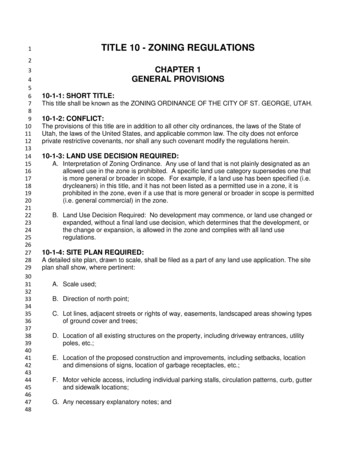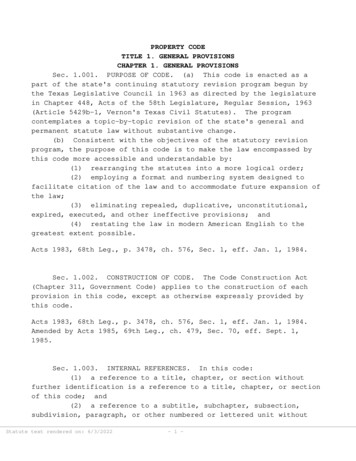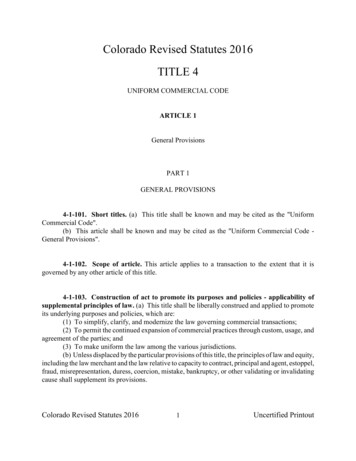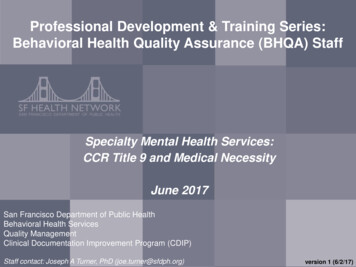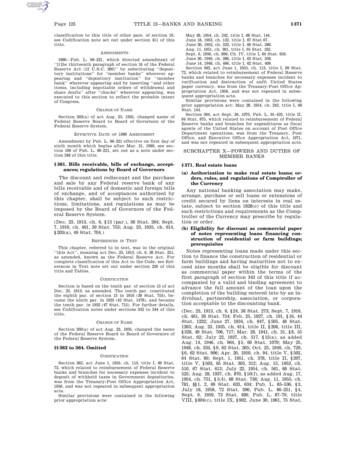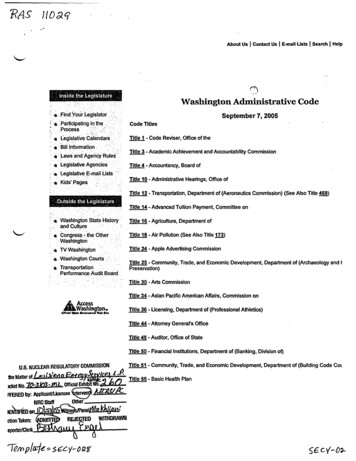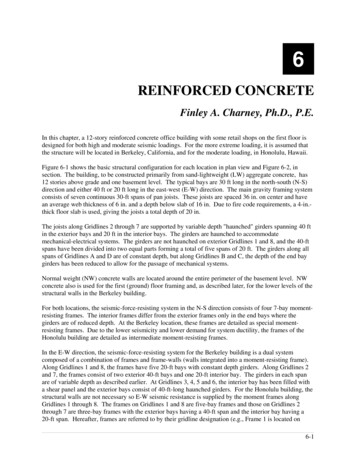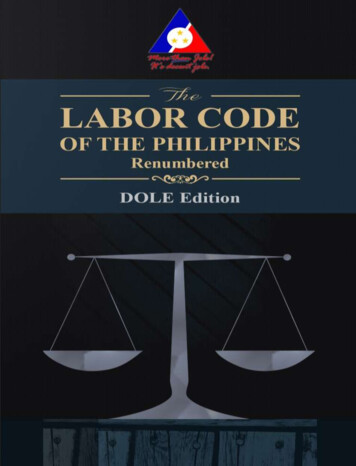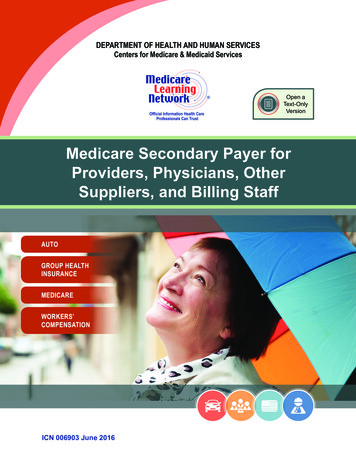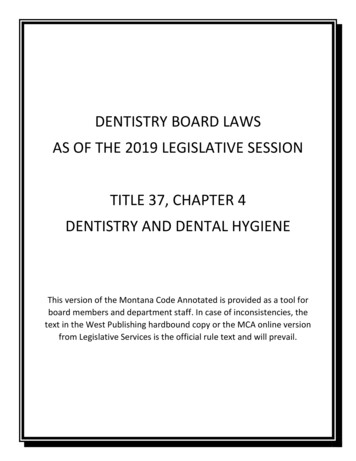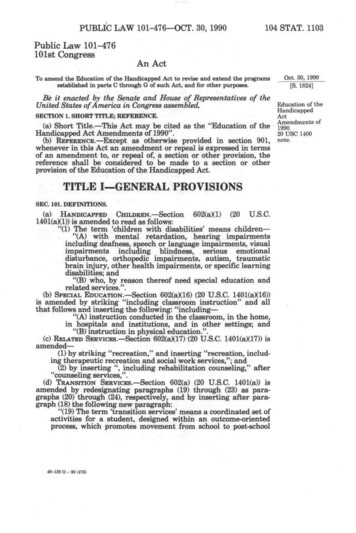
Transcription
104 STAT. 1103PUBLIC LAW 101-476—OCT. 30, 1990Public Law 101-476101st CongressAn ActTo amend the Education of the Handicapped Act to revise and extend the programsestablished in parts C through G of such Act, and for other purposes.Oct. 30, 1990[S. 1824]Be it enacted by the Senate and House of Representatives of theEducation of theUnited States of America in Congress assembled,SECTION 1. SHORT TITLE; REFERENCE.(a) Short Title.—This Act may be cited as the "Education of theHandicapped Act Amendments of 1990".(b) REFERENCE.—Except as otherwise provided in section 901,whenever in this Act an Eimendment or repeal is expressed in termsof an amendment to, or repeal of, a section or other provision, thereference shall be considered to be made to a section or otherprovision of the Education of the Handicapped Act.TITLE I—GENERAL PROVISIONSSEC. 101. Xl)(20U.S.C.1401(a)(1)) is amended to read as follows:"(1) The term 'children with disabilities' means children—"(A) with mental retardation, hearing impairmentsincluding deafness, speech or language impairments, visualimpairments including blindness, serious emotionaldisturbance, orthopedic impairments, autism, traumaticbrain injury, other health impairments, or specific learningdisabilities; and"(B) who, by reason thereof need special education andrelated services.".(b) SPECIAL EDUCATION.—Section 602(a)(16) (20 U.S.C. 1401(a)(16))is amended by striking "including classroom instruction" and allthat follows and inserting the following: "including—"(A) instruction conducted in the classroom, in the home,in hospitals and institutions, and in other settings; and"(B) instruction in physical education.".(c) RELATED SERVICES.—Section 602(aX17) (20 U.S.C. 1401(aX17)) isamended—(1) by striking "recreation," and inserting "recreation, including therapeutic recreation and social work services,"; and(2) by inserting ", including rehabilitation counseling," after"counseling services,".(d) TRANSITION SERVICES.—Section 602(a) (20 U.S.C. 1401(a)) isamended by redesignating paragraphs (19) through (23) as paragraphs (20) through (24), respectively, and by inserting after paragraph (18) the following new paragraph:"(19) The term 'transition services' means a coordinated set ofactivities for a student, designed within an outcome-orientedprocess, which promotes movement from school to post-school49-139 O - 90 (476)HandicappedActAmendments of1990.20 u s e 1400note.
104 STAT. 1104PUBLIC LAW 101-476—OCT. 30, 1990activities, including post-secondary education, vocational training, integrated emplo3mient (including supported employment),continuing and adult education, adult services, independentliving, or community participation. The coordinated set ofactivities shall be based upon the individual student's needs,taking into account the student's preferences and interests, andshall include instruction, community experiences, the development of employment and other post-school adult living objectives, and, when appropriate, acquisition of daily living skillsand functional vocational evaluation.".(e) INDIVIDUAUZED EDUCATION PROGRAM.—Section 602(aX20), asredesignated by subsection (d) of this section, is amended—(1) by redesignating subparagraphs (D) and (E) as subparagraphs (E) and (F), respectively, and by inserting after subparagraph (C) the following new subparagraph:"(D) a statement of the needed transition services forstudents beginning no later than age 16 and annuallythereafter (and, when determined appropriate for theindividual, beginning at age 14 or younger), including, whenappropriate, a statement of the interagency reponsibilitiesor linkages ( r both) before the student leaves the schoolsetting,", and(2) by inserting after subparagraph (F) (as so redesignated) thefollowing: "In the case where a participating agency, other thanthe educational agency, fails to provide agreed upon services,the educational agency shall reconvene the lEP team to identifyalternative strategies to meet the transition objectives.".(f) PuBuc OR PRIVATE NONPROFIT AGENCY OR ORGANIZATION.—Section 602(aX24XA), as redesignated by subsection (d) of this section, is amended by inserting before the period the following: "andthe Bureau of Indian Affairs of the Department of the Interior(when acting on behalf of schools operated by the Bureau forchildren and students on Indian reservations) and tribally controlledschools funded by the Department of the Interior".(g) ASSISTIVE TECHNOLOGY DEVICE.—Section 602(a), as amended bysubsection (d) of this section, is imended by adding at the end thefollowing new paragraph:"(25) The term 'assistive technology device' means any item,piece of equipment, or product system, whether acquiredcommercially off the shelf, modified, or customized, that is usedto increase, maintain, or improve functional capabilities ofindividuals with disabilities.".(h) ASSISTIVE TECHNOLOGY SERVICE.—Section 602(a), as amendedby subsection (g) of this section, is amended by adding at the end thefollowing new paragraph:"(26) The term 'assistive technology service' means any service that directly assists an individual with a disability in theselection, acquisition, or use of an assistive technolc y device.Such term includes—"(A) the evaluation of the needs of an individual with adisability, including a functional evaluation of the individual in the individual's customary environment;"(B) purchasing, leasing, or otherwise providing for theacquisition of assistive technology devices by individualswith disabilities;
PUBLIC LAW 101-476—OCT. 30, 1990104 STAT. 1105"(C) selecting, designing, fitting, customizing, adapting,appljdng, maintaining, repairing, or replacing of assistivetechnology devices;"(D) coordinating and using other therapies, interventions, or services with assistive technology devices, such asthose associated with existing education and rehabilitationplans and programs;"(E) training or technical gissistance for an individualwith disabilities, or, where appropriate, the family of anindividual with disabilities; and"(F) training or technical assistance for professionals(including individuals providing education and rehabilitation services), employers, or other individuals who provideservices to, employ, or are otherwise substantially involvedin the major life functions of individuals with disabilities.",(i) UNDERREPRESENTED.—Section 602(a), as amended by subsection(h) of this section, is amended by adding at the end the followingnew paragraph:"(27) The term 'underrepresented' means populations such asminorities, the poor, the limited English proficient, and individuals with disabilities.".SEC. 102. NOTICE OF INQUIRY.(a) PUBLICATION.—Not later than 30 days after the date of the Federalenactment of the Education of the Handicapped Act Amendments of ujf* [- 1990, the Secretary shall publish a Notice of Inquiry in the Federal " "Register for the purpose of soliciting public comments regarding theappropriate components of an operational definition under such Actfor the term "attention deficit disorder" (hereinafter referred to inthis section as the "disorder") in accordance with subsection (bX2).(b) PUBLIC COMMENT.—(1) The Notice of Inquiry published under subsection (a) shallprovide for a 120-day period for public comment.(2) The Notice of Inquiry shall request comments concerningthe following issues:(A) How should the disorder be described operationallyfor purposes of qualifying a child for special education andrelated services under part B of the Education of the Handicapped Act.(B) What criteria should be included in the definition to'qualify children with the disorder whose disability is comparable in severity to other children with disabilities currently determined to be eligible for special education andrelated services under part B of the Education of the Handicapped Act.(C) What specific manifestations of the disorder, if any,should be included in the definition.(D) Whether the definition should include references totcharacteristics or circumstances that produce transientinattentive behaviors that, in and of themselves, would notmake a child eligible for special education and relatedservices under the definition of the disorder.(E) Whether the definition should address the concurrence of this disorder with other disabilities such as specificlearning disabilities or serious emotional disturbance, andif so addressed, the manner in which such is to be accomplished.
104 STAT. 1106PUBLIC LAW 101-476—OCT. 30, 1990(F) Whether guidelines should be provided to State andlocal educational agencies regarding their obligation to conduct in evaluation of a child suspected of having thisdisorder, and a description of such guidelines.(G) Who should be authorized to conduct an assessment ofa child having or suspected of having the disorder andwhether the assessment should be conducted by more thanone individual (such as a teacher and a psychologist).(H) What provisions should be included in the definitionand what additional steps, if any, not currently required bythe regulations implementing part B of the Education ofthe Handicapped Act, should be included to ensure thatracial, ethnic, and linguistic minorities are not misclassifiedunder this definition.(c) REPORT TO COMMITTEES.—Not later than 30 days after the closeof the comment period referred to in subsection G))(l), the Secretaryshall transmit the public comments received in response to theNotice of Inquiry in a usable form, accompanied by a documentsummarizing such comments, to the Committee on Labor andHumsm Resources of the Senate and the Committee on Educationand Labor of the House of Representatives.SEC. 103. ABROGATION OF STATE SOVEREIGN IMMUNITY.Part A (20 U.S.C. 1400 et seq.) is amended by inserting aftersection 603 the following new section:"ABROGATION OF STATE SOVEREIGN IMMUNITY20 use 1403."SEC. 604. (a) A State shall not be immune under the eleventhamendment to the Constitution of the United States from suit inFederal court for a violation of this Act."(b) In a suit against a State for a violation of this Act, remedies(including remedies both at law and in equity) are available for sucha violation to the same extent as such remedies are available forsuch a violation in the suit against any public entity other than aState."(c) The provisions of subsections (a) and (b) shall take effect withrespect to violations that occur in whole or part after the date of theenactment of the Education of the Handicapped Act Amendments of1990.".SEC. 104. REPORTS, EVALUATIONS, FINDINGS, AND OTHER PROVISIONSGENERALLY APPLICABLE TO PARTS C THROUGH G.Part A (20 U.S.C. 1400 et seq.) is amended by adding at the end thefollowing new section:"ADMINISTRATIVE PROVISIONS APPUCABLE TO PARTS C THROUGH G ANDSECTION 61820 use 1409."SEC. 610. (a) The Secretary shall maintain a process for developing a program plan for the implementation of each of the programsauthorized under section 618 and parts C through G. The plan shallinclude program goals, objectives, strategies, and priorities. Inconducting the process, the Secretary shall involve individuals withdisabilities, parents, professionals, and representatives of State andlocal educational agencies, private schools, institutions of highereducation, and nationsd organizations who have interest and expertise in the program.
PUBLIC LAW 101-476—OCT. 30, 1990104 STAT. 1107"Ot)) In awarding grants, contracts, and cooperative agreementsunder parts C through G, the Secretary, where appropriate, shallrequire applicants to demonstrate how they will address, in whole orin part, the needs of infants, toddlers, children, and youth withdisabilities from minority bacl grounds."(c) In awarding grants, contracts, or cooperative agreementsunder parts C through G the Secretary, where appropriate, mayrequire applicants to address the various transitions that a childwith a disability may face throughout such child's years in school,including—"(1) the transition from medical care to special education forthose children with disabilities, including chronic healthimpairments, who may require individualized health-relatedservices to enable such children to participate in, or benefitfrom, special education;"(2) the transition between residential placement and community-based special education services; and"(3) the transition between a separate educational placementand the regular classroom setting."(d) The Secretary shall conduct directly, or by contract or cooperative agreement with appropriate entities, independent evaluations of the programs authorized under section 618 and under partsC through G, and may for such purpose use funds appropriated tocarry out such provisions. The findings of the evaluators shall beutilized in the planning process under subsection (a) for the purposeof improving the programs. The evaluations shall determine thedegree to which the program is being conducted consistent with theprogram plan and meeting its goals and objectives. The Secretaryshall submit to the appropriate committees of the Congress theresults of the evaluations required by this subsection."(e) The Secretary shall report on the program plans required insubsection (a) and findings from the evaluations under subsection (d)in the annual report to the Congress required under section 618."(f) The Secretary shall develop effective procedures for acquiringand disseminating information derived from programs and projectsfunded under parts C through G, as well as information generatedfrom studies conducted and data collected under section 618."(g) The Secretary shall, where appropriate, require recipients ofall grants, contracts, and cooperative agreements under parts Cthrough G to prepare reports describing their procedures, findings,and other relevant information in a form that will maximize thedissemination and use of such procedures, findings, and information.The Secretary shall require their delivery, as appropriate, to theRegional and Federal Resource Centers, the Clearinghouses, and theTechnical Assistance to Parents Programs (TAPP) assisted underparts C and D, as well as the National Diffusion Network, the ERICClearinghouse on the Handicapped and Gifted, and the Child andAdolescent Service Systems Program (CASSP) under the NationalInstitute of Mental Health, appropriate parent and professionalorganizations, organizations representing individuals with disabilities, and such other networks as the Secretary may determine to beappropriate."(h)(1) The Secretary shall convene, in accordance with paragraph(2), panels of experts who are competent, by virtue of their trainingor experience, to evaluate proposals under section 618 and parts Cthrough G.Infants andchildren.Minorities.Governmentcontracts.
104 STAT. 1108PUBLIC LAW 101-476—OCT. 30, 1990"(2) Panels under paragraph (1) shall be composed of individualswith disabilities, parents of such individuals, individuals from thefields of special education, related services, and other relevantdisciplines."(3) The Secretary shall convene panels under paragraph (1) forany application that includes a total funding request exceeding 60,000 and may convene or otherwise appoint panels for applications that include funding requests that are less than such amount."(4) Panels under paragraph (1) shall include a majority of nonFederal members. Such non-Federal members shall be providedtravel and per diem not to exceed the rate provided to othereducational consultants used by the Department of Education andshall be provided consultant fees at such a rate."(5) The Secretary may use funds available under section 618 andparts C through G to pay expenses and fees of non-Federal membersof the panels."(i) The Secretary shall conduct at least 1 site visit for each grant,contract, and cooperative agreement receiving 300,000 or moreannually under parts C through G."(jXl) With respect to the discretionary programs authorized byparts C through G, the Congress finds as follows:"(A)(i) The Federal Government must be responsive to thegrowing needs of an increeisingly more diverse society. A moreequitable allocation of resources is essential for the FederalGovernment to meet its responsibility to provide an equal educational opportunity for all individuals."(ii) America's racial profile is rapidly changing. While therate of increase for white Americans is 3.2 percent, the rate ofincrease for racial and ethnic minorities is much higher: 38.6percent for Hispanics, 14.6 percent for African-Americans, and40.1 percent for Asians and other ethnic groups."(iii) By the year 2000, this Nation will have 260,000,000people, one of every three of whom will be either AfricanAmerican, Hispanic, or Asian-American."(iv) Taken together as a group, it is a more frequentphenomenon for minorities to comprise the majority of publicschool students. Large city school populations are overwhelmingly minority, e.g., Miami, 71 percent; Philadelphia, 73 percent; Baltimore, 80 percent."(v) Recruitment efforts within special education at the levelof preservice, continuing education, and practice must focus onbringing larger numbers of minorities into the profession inorder to provide appropriate practitioner knowledge, rolemodels, and sufficient manpower to address the clearly changing demography of special education."(vi) The limited English proficient population is the fastestgrowing in our Nation, and the growth is occurring in manyparts of our Nation. In the Nation's 2 largest school districts,limited-English students make up almost half of Eill studentsinitially entering school at the kindergarten level. Studies havedocumented apparent discrepancies in the levels of referral andplacement of limited-English proficient children in special education. The Department of Education has found that servicesprovided to limited-English proficient students often do notrespond primarily to the pupil's academic needs. These trendspose special challenges for special education in the referral.
PUBLIC LAW 101-476—OCT. 30, 1990104 STAT. 1109assessment, and services for our Nation's students from nonEnglish language backgrounds."(B)(i) Greater efforts are needed to prevent the intensification of problems connected with mislabeling and high dropoutrates among minority children with disabilities."(ii) More minority children continue to be served in specialeducation than would be expected from the percentage of minority students in the general school population."(iii) Poor African-American children are 3.5 times morelikely to be identified by their teacher as mentally retardedthan their white counterpart."(iv) Although African-Americans represent 12 percent ofelementary and secondary enrollments, they constitute 28 percent of total enrollments in special education."(v) The drop out rate is 68 percent higher for minorities thanfor whites."(vi) More than 50 percent of minority students in large citiesdrop out of school."(C)(i) The opportunity for full participation in awards forgrants and contracts; boards of organizations receiving fundsunder this Act; and peer review panels; and training of professionals in the area of special education by minority individuals,organizations, and historically Black colleges and universities isessential if we are to obtain greater success in the education ofminority children with disabilities."(ii) In 1989, of the 661,000 college and university professors,4.6 percent were African-American and 3.1 percent were Hispanic. Of the 3,600,000 teachers, prekindergarten through highschool, 9.4 percent were African-American and 3.9 percent wereHispanic."(iii) Students from minority groups comprise more than 50percent of K-12 public school enrollment in seven States yetminority enrollment in teacher training programs is less than15 percent in all but six States."(iv) As the number of African-American and Hispanic students in special education increases, the number of minorityteachers and related service personnel produced in our collegesand universities continues to decrease."(v) Ten years ago, 12.5 percent of the United States teachingforce in public elementary and secondary schools were membersof a minority group. Minorities comprised 21.3 percent of thenational population at that time and were clearlyunderrepresented then among employed teachers. Today, theelementary and secondary teaching force is 3 to 5 percentminority, while one-third of the students in public schools areminority children."(vi) As recently as 1984-85, Historically Black Colleges andUniversities (HBCUs) supplied nearly half of the African-American teachers in the Nation. However, in 1988, HBCUs receivedonly 2 percent of the discretionary funds for special educationand related services personnel training."(vii) While African-American students constitute 28 percentof total enrollment in special education, only 11.2 percent ofindividuals enrolled in preservice training programs for specialeducation are African-American.39-194 O - 91 - 5 : QL 3 Part 2
104 STAT. 1110PUBLIC LAW 101-476—OCT. 30, 1990"(viii) In 1986-87, of the degrees conferred in education at theB.A., M.A., and Ph.D levels, only 6, 8, eind 8 percent, respectively, were awarded to African-American or Hispanic students."(D) Minorities and underserved persons are socially disadvantaged because of the lack of opportunities in training andeducational programs, undergirded by the practices in the private sector that impede their full participation in the mainstream of society."(2) The Congress further finds that these conditions can begreatly improved by providing opportunities for the full participation of minorities through the implementation of the followingrecommendations:"(A) Implementation of a policy to mobilize the Nation'sresources to prepare minorities for careers in special educationand related services."(B) This policy should focus on—"(i) the recruitment of minorities into teaching; and"(ii) financially assisting HBCUs and other institutions ofhigher education (whose minority student enrollment is atleast 25 percent) to prepare students for special educationand related service careers."(C)(i) The Secretary shall develop a plan for providing outreach services to the entities described in clause (ii) in order toincrease the participation of such entities in competitions forgrants, contracts, and cooperative agreements under any ofparts C through G."(ii) The entities referred to in clause (i) are—"(I) Historically Black Colleges and Universities andother institutions of higher education whose minority student enrollment is at least 25 percent;"(II) eligible institutions as defined in section 312 of theHigher Education Act of 1965;"(III) nonprofit and for-profit agencies at least 51 percentowned or controlled by one or more minority individuals;and"(IV) underrepresented populations,"(iii) For the purpose of implementing the plan required inclause (i), the Secretary shall, for each of the fiscal years 1991through 1994, expend 1 percent of the funds appropriated forthe fiscal year involved for carrying out parts C through G."(3) The Secretary shall exercise his/her utmost authority,resourcefulness, and diligence to meet the requirements of thissubsection."(4) Not later than January 31 of each year, starting with fiscalyear 1991, the Secretary shall submit to Congress a final report onthe progress toward meeting the goals of this subsection during thepreceding fiscal year. The report shall include—"(i) a full explanation of any progress toward meeting thegoals of this subsection; and"(ii) a plan to meet the goals, if necessary.".
PUBLIC LAW 101-476—OCT. 30, 1990104 STAT. 1111TITLE II—ASSISTANCE FOR EDUCATIONOF ALL HANDICAPPED INDIVIDUALSSEC. 201. SETTLEMENTS AND ALLOCATIONS.Section 611(f) (20 U.S.C. 1411(f)) is amended—(1) in paragraph (1), in the first sentence, by inserting "(A)"after "reservations" and by inserting before the period thefollowing: ", and (B) for whom services were provided throughcontract with an Indian tribe or organization prior to fiscal year1989"; and(2) by adding at the end the following new paragraph:"(3) Before March 1, 1991, the Secretary of the Interior shallsubmit to the appropriate C!ommittees of the Congress a plan for theprovision of services under this Act to all children with disabilitiesresiding on reservations, whether or not such reservation is servedby a B.I.A. funded school. Such plan shall provide for the coordination of services benefiting these children from whatever source,including Tribes, the State in which the child resides and entities ofsuch State, the Indian Health Service, other B.I.A. divisions andother Federal agencies. In developing such a plan, the Secretaryshall consult with all interested and involved parties. Such a planmay not be based upon a blanket assumption or interpretation thatdenies Federal or Interior responsibility for any group or class ofchildren or settings, but shall be based upon the needs of thechildren and the system best suited for meeting those needs, andmay involve the establishment of service agreements between theB.I.A. and other entities.".SEC. 202. STATE PLANS.Section 613(a)(3) (20 U.S.C. 1413(a)(3)) is amended to read asfollows:"(3) describe, consistent with the purposes of this Act, acomprehensive system of personnel development that shallinclude—"(A) a description of the procedures and activities theState will undertake to ensure an adequate supply of qualified special education and related services personnel,including—"(i) the development and maintenance of a system fordetermining, on an annual basis—"(I) the number and type of personnel, includingleadership personnel, that are employed in theprovision of special education and related services,by area of specialization, including the number ofsuch personnel who are employed on an emergency, provisional, or other basis, who do not holdappropriate State certification or licensure; and"(II) the number and type of personnel, includingleadership personnel, needed, and a projection ofthe numbers of such personnel that will be neededin five years, based on projections of individuals tobe served, retirement and other leaving of personnel from the field, and other relevant factors;"(ii) the development and maintenance of a systemfor determining, on an annual basis, the institutions of
104 STAT. 1112PUBLIC LAW 101-476—OCT. 30, 1990higher education within the State that are preparingspecial education and related services personnel,including leadership personnel, by area of specialization, including—"(I) the numbers of students enrolled in suchprograms, and"(11) the number who graduated with certification or licensure, or with credentials to qualifyfor certification or licensure, during the past year;and"(iii) the development, updating, and implementationof a plan that—"(I) will address current and projected specialeducation and related services personnel needs,including the need for leadership personnel; and"(II) coordinates and facilitates efforts amongState and local educational agencies, institutions ofhigher education, and professional associations torecruit, prepare, and retain qualified personnel,including personnel from minority backgrounds,and personnel with disabilities; and"(B) a description of the procedures and activities theState will undertake to ensure that all personnel necessaryto carry out this part are appropriately and adequatelyprepared, including—"(i) a system for the continuing education of regularand special education and related services personnel;"(ii) procedures for acquiring and disseminating toteachers, administrators, and related services personnel significant knowledge derived from education research and other sources; and"(iii) procedures for adopting, where appropriate,promising practices, materials, and technology.".Grant 0 u s e 1418SEC. 203. EVALUATIONSection 618 is amended to read as follows:EVALUATION AND PROGRAM INFORMATION"SEC. 618. (a) The Secretary shall, directly or by grant, contract, orcooperative agreement, collect data and conduct studies, investigations, analyses, and evaluations—"(1) to assess progress in the implementation of this Act;"(2) to assess the impact and effectiveness of State and localefforts, and efforts by the Secretary of the Interior, to provide—"(A) free appropriate public education to children andyouth with disabilities; and"(B) early intervention services to infants and toddlerswith disabilities; and"(3) to provide—"(A) Congress with information relevant to policymaking;and"(B) State, local, and Federal agencies, including theDepartment of the Interior, with information relevant toprogram management, administration, delivery, andeffectiveness with respect to such education and early intervention services.
PUBLIC LAW 101-476—OCT. 30, 1990104 STAT. 1113"(bXD In carrying out subsection (a), the Secretary, on at least anannual basis (except as provided in subparagraph (E)), shall obtaindata concerning programs and projects assisted under this Act andunder other Federal laws relating to infants, toddlers, children, andyouth with disabilities, and such additional information, from Stateand local educationed agencies, the Secretary of the Interior, andother appropriate sources, including designated lead agencies underpart H (except that during fiscal year 1992 such entities may notunder this subsection be required to provide data regarding traumatic brain injury or autism), including—"(A) the number of infants, toddlers, children, and youth withdisabilities in each State receiving a free appropriate publiceducation or early intervention services—"(i) in age groups 0-2 and 3-5, and"(ii) in age groups 6-11, 12-17, and 18-21, by disabilitycategory;"(B) the number of children and youth with disabilities ineach State, by disability category, who—(i) are participating in regular educational programs(consistent with the re
SECTION 1. SHORT TITLE; REFERENCE. (a) Short Title.—This Act may be cited as the "Education of the Handicapped Act Amendments of 1990". (b) REFERENCE.—Except as otherwise provided in section 901, whenever in this Act an Eimendment or repeal is expressed in terms of an amendment to, or repeal of, a section or other provision, the
